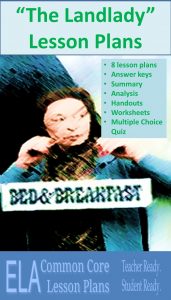Mr. Weaver had traveled down from the lunch room on the slow afternoon cart, with a stop at the library on the way, and by the time he got to his classroom it was about one o’clock in the afternoon and the assistant principal was coming from a bad observation in the classroom opposite the school’s entrance. His air was deadly cold and the red observation pen was like a flat blade of ice on his teacher observation rubric.
“Excuse me,” he said, “but are there “Landlady” lesson plans not too far away from here? Because I’m here to observe you and you mentioned something about a “Landlady” analysis?”
Luckily you had this “Landlady” Lesson Plan for Making Inferences.
“The Landlady” Analysis and Summary
Hey, maybe you read this when you were in high school and don’t remember everything? Or perhaps you’re just too busy grading the 436 essays you assigned the week before Spring Break? Either way, here’s a summary of “The Landlady” by Roald Dahl that you can use to help with your “Landlady” Lesson Plan for Making Inferences.
Summary
Billy Weaver has arrived in Bath—the town in England, not the thing in your bathroom. He’s there on a work assignment from London and it’s been a rather inconvenient train ride and he just wants to get a room for the night and take care of business in the morning.
He’s on his way to The Bell and Dragon when another bed and breakfast captures his fancy. The landlady awaits and greets him warmly, in a somewhat creepy manner, kind of like that overly friendly guy in the Wal-Mart toy aisle who, unbeknownst to you, is actually trying to recruit you into his MLM company. Actually, the landlady is even more creepy. You’ll see.
Billy Weaver’s youth—he’s only 17—and naivete comes into play as he signs the guest book, a guest book with only two names in it. (Note to reader: If you happen across a bed and breakfast in England, or any other country, that has only two names in the guest book, leave, immediately. Better yet, run like hell!)
Billy Weaver seems to recognize the names from somewhere, from the newspaper or something, but he can’t quite place why. The landlady assures him the two boys are still there. The landlady brings Billy some tea, which he drinks. She offers him more tea, but Billy declines because the tea has a bitter almond taste.
Cyanide has a bitter almond taste.
Duh! Duh! Daaaaaaaaaaa!
Analysis
This “Landlady” analysis will help you form “Landlady” lesson plans.
- Irony. I think it’s safe to say that most bed and breakfasts treat their guests a tad better than this particular landlady. And who would expect such a dastardly act from a sweet old lady? There’s, perhaps, a bit of dramatic irony here because the reader guesses long before Billy that there ain’t nothing good happening here. It’s also ironic that I’m an English teacher who used the word “ain’t” in the previous sentence. You wouldn’t expect that, would you?
- Setting. Nothing good happens late at night in England, especially on the street Billy walks down.
- Foreshadowing. We’re not exactly sure what this landlady is up to, but there are enough suggestions to indicate Billy will soon join the other two young men who have signed the guest book.
- Making Inferences. Much of what happens in “The Landlady” must be inferred by the reader.
- “The Landlady” contains elements of horror.
- Character. The landlady is quite the landlady.
ELA Standards
I guess you should have some objectives with your lesson plan, right?
- RL.9-10.1 Cite strong and thorough textual evidence to support analysis of what the text says explicitly as well as inferences drawn from the text.
- RL.9-10.3 Analyze how complex characters (e.g., those with multiple or conflicting motivations) develop over the course of a text, interact with other characters, and advance the plot or develop the theme.
- RL.9-10.5 Analyze how an author’s choices concerning how to structure a text, order events within it (e.g., parallel plots), and manipulate time (e.g., pacing, flashbacks) create such effects as mystery, tension, or surprise.
- RL.9-10.6 Analyze a particular point of view or cultural experience reflected in a work of literature from outside the United States, drawing on a wide reading of world literature.
Last Updated on July 27, 2019 by Trenton Lorcher
Share This:
